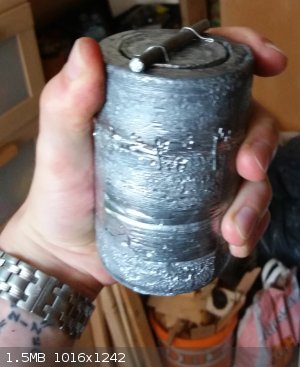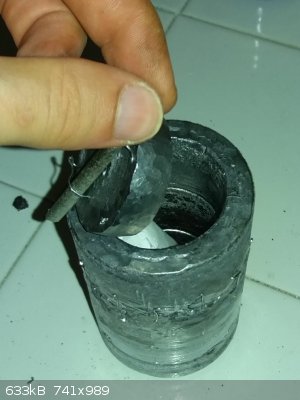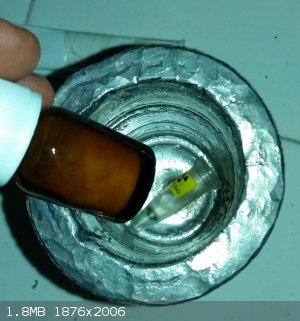coppercone
Hazard to Others
  
Posts: 133
Registered: 5-5-2018
Member Is Offline
|
|
how do you store radioactive materials?
Does anyone make their own boxes?
I have a small, weak gamma emitter, meant for scillinators. Rather then leaving it in its 1950's original container, which was basically an altoids
tin, I decided to smelt some lead discs, which I will glue into a wooden box that I have made.
Super unnecessary but I think it is quite fun to make. I used sodium silicate in sand to make a form (hardened with CO2). I melted my lead scraps in
the sand mold, using a fire brick as a base, with a torch. Kinda fun woodworking project.
I don't know how strong it is, but it was enough to trigger a hard to trigger gieger russian tube close up.
It's easy to polish the face up with some sand paper (careful with the dust) and then coat it with a thin layer of polyurethane for stability.
[Edited on 9-7-2018 by coppercone]
|
|
|
Ubya
International Hazard
    
Posts: 1232
Registered: 23-11-2017
Location: Rome-Italy
Member Is Offline
Mood: I'm a maddo scientisto!!!
|
|
well what a coincidence, last week after many ideas i made my lead pig, the main problem was finding 2 metal containers (cylindrical) that would fit
one inside the other with a precise gap between the two. i used a tin can used for an asian beverage (lucky) and an aluminium deodorant spry.
i don't have any photos of the setup but i simply cut open the can, lowered the deodorant cylinder (empty and with a hole to let any hot gases escape)
to make a 1cm gap in the bottom and the sides, secured it to the can with wood pieces (in a previous attempt i didn't think about bouyancy...), i
melted about 3kg of lead from scrap bullets and a dead lead battery and carefully poured it into the mold. removing the deodorant bottle was a pain as
it was stuck, but after shredding it to pieces i removed all of it, the outer can i just pealed away.
  
it now contains a vial with 5g of uranyl acetate, 2 americium buttons and a few thoriated tungsten electrodes. way overkill but in the future i hope
to get some hotter stuff
---------------------------------------------------------------------
feel free to correct my grammar, or any mistakes i make
---------------------------------------------------------------------
|
|
|
diddi
National Hazard
   
Posts: 723
Registered: 23-9-2014
Location: Victoria, Australia
Member Is Offline
Mood: Fluorescent
|
|
you only need pigs for gamma emitters. i have some weighing bottles i use for my small radiominerals and metals.
Beginning construction of periodic table display
|
|
|
Sulaiman
International Hazard
    
Posts: 3555
Registered: 8-2-2015
Location: 3rd rock from the sun
Member Is Offline
|
|
How do you know that there is not a significant void/bubble in the lead ?
|
|
|
coppercone
Hazard to Others
  
Posts: 133
Registered: 5-5-2018
Member Is Offline
|
|
You mean if its melted in the tin? Typically you would stir it around with a metal rod and maybe even add some wax or other flux to it, and scoop off
the dross.
I find it hard to imagine lead forming significant voids. When I cut some parts I made they are always solid. The only thing you do have happen is the
top and bottoms might buckle a bit during cooling and form a concave surface.
I think voids are more of an issue when metal is poured into complex geometries where the mold actually cools it down (like die casting complex
parts), if you actually handle molten lead you will see that its incredibly fluid.
Also, the liquid will have a big range between boiling and melting, if you just bearly melt it MAYBE something like this could happen. Some molds are
preheated, but its not necessary with a big cylindrical shape.
Try melting a pot of it, it is extremely fluid, like water.
If you want to do a can mold (I make lead hammers this way), just throw your lead in a can and set a blow torch to blow over it directly on the top.
If you want a protrusion or handle the easy way is to get some epoxy putty to make a seal, then chip it off later.. just watch for spills and fumes
from the can/sealing materials. I like sodium silicate because it does not fume or anything like that... compared to something that uses oil as a
binder. You can set it on a fire brick to protect the surface.
Some metals will be more goopy when they are bearly molten, but when you get them to the correct so called casting temperature, voids are not so much
an issue.. Sand is a bit better since it insulates pretty good when casting aluminum. It will also take a while to solidify, and I found it solidifies
from the edges to the top.. if you poke around with a screw driver while it is cooling you will feel the sides begin to solidify before the top does.
I think the bigger hazard is handling the lead and the lead fumes. I recommend you make containers and coat the lead with polyurethane.
Youtube is crammed with lead casting videos.
Also when you melt lead, give it a good stir, it will turbulate it and most insoluble impurities will float right to the top where you can scoop them
off with a spoon. If you use something like home depot lead sheet to melt down, you will get quite a bit of this 'dross'.
Note that using bean cans or something will result in the ribbing transferring over to the lead. If you use fine sand and a binder, the texture will
match the surface of the sand.
I noticed that cast iron parts, even simple geometries, seem to have voids. I can only speculate this because the mold is not preheated enough, the
correct casting temperature is not reached, or the pour is very turbulent.
I never worked with casting iron or steel, it is too dangerous unless you are really serious about it. You need dry floors to prevent spill concrete
explosions/spalling, kiln suits, furnace equipment, serious ventilation, reliable crucibles, etc.
In terms of ease you would have like Lead -> Aluminum -> Bronze -> Copper -> (big jump in danger) Iron -> Steel -> Exotic alloys
Also cast parts are typically inferior to machined ones because of stresses with things like iron and aluminum. I think bronze casting is decent
though. Lead hardly matters.
[Edited on 10-7-2018 by coppercone]
|
|
|
JJay
International Hazard
    
Posts: 3440
Registered: 15-10-2015
Member Is Offline
|
|
Perhaps the easiest way to be sure is to use Archimedes' Principle: https://www.youtube.com/watch?v=0G-pnXvfo_4
|
|
|
Ubya
International Hazard
    
Posts: 1232
Registered: 23-11-2017
Location: Rome-Italy
Member Is Offline
Mood: I'm a maddo scientisto!!!
|
|
in my case the wall thickness is maybe 1cm, voids would easly show breaking the surface. in my casting i had a few voids, i didn't have a proper
crucible or stand, so i had to hold the container filled with lead on the flame using a long pair of thongs, holding 1kg of lead for 10 minutes while
the thongs also heat up is not the best thing so the last pour was colder than the previous two, 3 bubbles formed in the side, i filled them with
molten lead and hammered it to make it tight. the best thing was to start over but i already destroyed my mould...
---------------------------------------------------------------------
feel free to correct my grammar, or any mistakes i make
---------------------------------------------------------------------
|
|
|
Fulmen
International Hazard
    
Posts: 1693
Registered: 24-9-2005
Member Is Offline
Mood: Bored
|
|
The simplest way to ensure a void-free casting is to cast in a preheated mould. As long as the metal is liquid during the filling no voids should
form, with a thin walled mould and some heating this shouldn't be an issue. Proper fluxing also helps, add a bit of wax and stir thoroughly. Then
remove the surface dross and repeat until no more dross appears.
By heating the top part of the mould during solidification you can also avoid most (if not all) of the problems with shrinkage.
We're not banging rocks together here. We know how to put a man back together.
|
|
|
coppercone
Hazard to Others
  
Posts: 133
Registered: 5-5-2018
Member Is Offline
|
|
I am in shock that you managed to get voids with lead.
If you use a can, aiming a the flame downwards on it is better then trying to heat the can IMO. Every one of my lead casts came out like it ought to
with a simple mapp gas or acetylene torch for a 14lb hammer.
I mean like hit the lead pool with your torch so the heat goes from the molten surface to the bottom. You have no chance of spilling or anything funny
either, plus you don't need any special equipment, if its a open sand mold you just set the torch and aim the barrel downwards into the mold. If the
geometry is flat then you can put garbage lead in there and since you are working on fire brick with fused sand, you can easily stir and poke the
bottom to bring to the surface any trash.
[Edited on 10-7-2018 by coppercone]
|
|
|